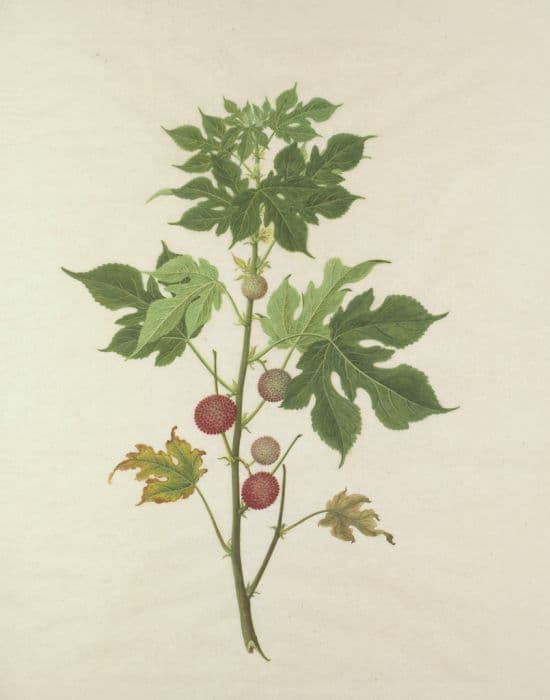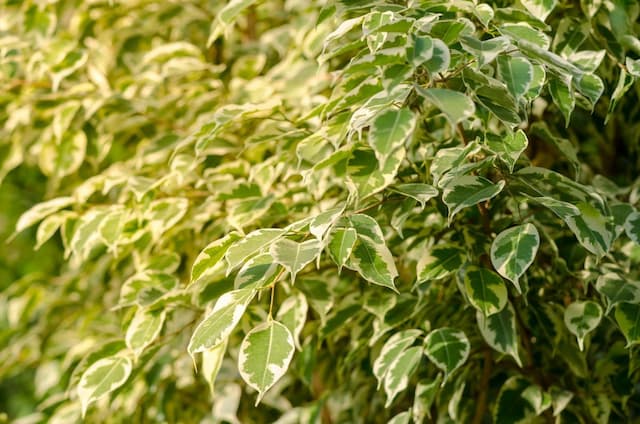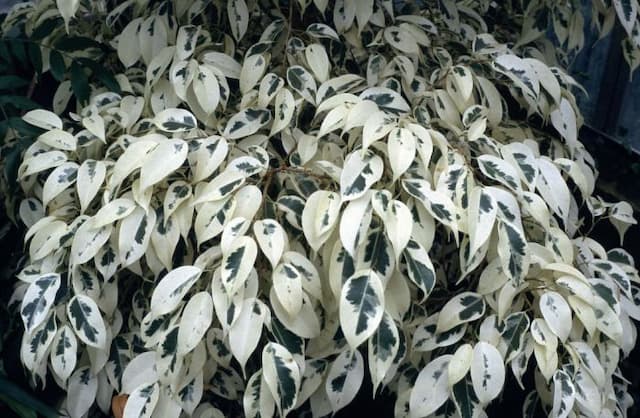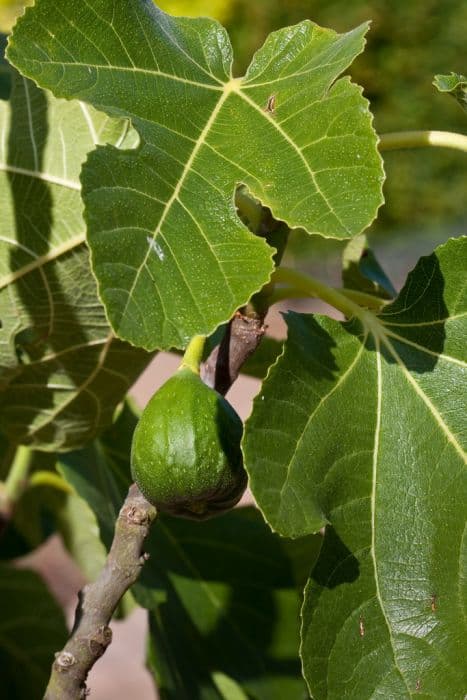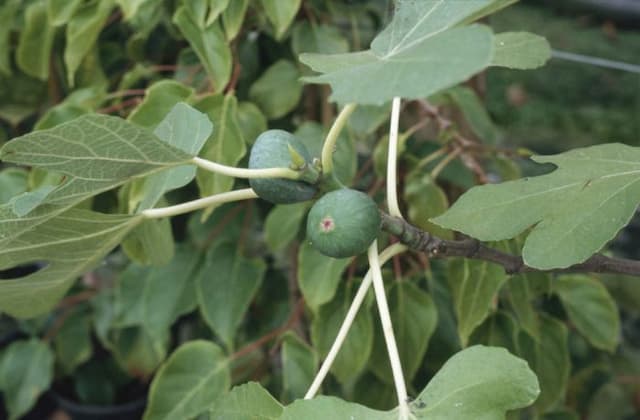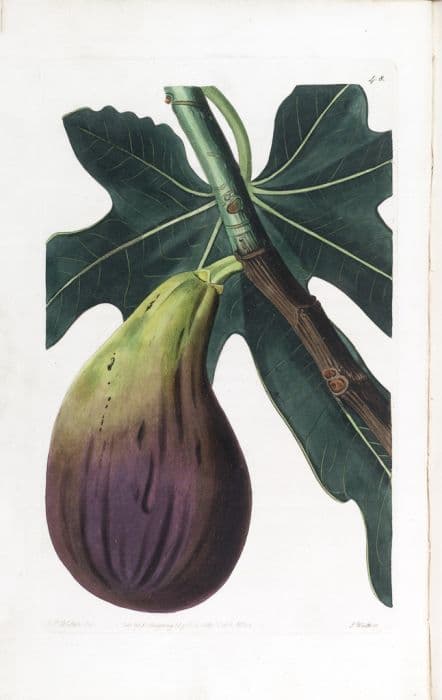Rubber Plant Ficus elastica 'Schrijveriana' (v)

ABOUT
Ficus elastica 'Schrijveriana', commonly known as the Rubber Plant, is recognized by its striking foliage. It has broad, glossy, and thick leaves that provide an attractive lush appearance. The leaves are a standout feature due to their variegation, displaying a beautiful pattern of green and cream colors. Each leaf has a prominent midrib, with multiple veins spanning its surface, giving it a structured and robust look. This variety of Rubber Plant typically features leaves that are oval with a slight point at the tip, creating a sense of elegance and poise. The glossy nature of the leaves catches the light, which can highlight the variegation and make the plant an eye-catching component in any space. The leaves grow from a central stem, which is sturdy to hold up the substantial leaves. The overall form of the Rubber Plant is one of being upright and tree-like in its growth habit, which can make it a statement piece in interior plant collections. Its ability to contribute significantly to the ambiance of a space is enhanced by its luxurious and vibrant foliage, which can bring a touch of the tropics into homes and offices.
About this plant
 Names
NamesFamily
Moraceae
Synonyms
Variegated Rubber Tree, Variegated Rubber Plant, Variegated Indian Rubber Tree
Common names
Ficus elastica 'Schrijveriana'.
 Toxicity
ToxicityTo humans
The Rubber Plant contains a sap that can be irritating to the skin and mucous membranes. If ingested, the sap can cause mouth and stomach irritation, leading to symptoms such as drooling, vomiting, and diarrhea. It is advisable to keep the Rubber Plant away from children and to wash hands after handling to prevent irritation.
To pets
The Rubber Plant is also toxic to pets. If ingested, the irritating sap can cause symptoms such as oral irritation, excessive drooling, vomiting, and difficulty swallowing in animals. It is important to keep this plant out of reach of pets to prevent accidental ingestion and potential health issues.
 Characteristics
CharacteristicsLife cycle
Perennials
Foliage type
Evergreen
Color of leaves
Variegated
Height
6 feet [183 cm]
Spread
3-4 feet [91-122 cm]
Plant type
Shrub
Hardiness zones
10-12
Native area
Southeast Asia
Benefits
 General Benefits
General Benefits- Decorative Appeal: The Ficus elastica 'Schrijveriana' (variety), also known as the Rubber Plant, has distinct variegated foliage that adds a decorative touch to any indoor space.
- Easy Maintenance: This plant is known for being relatively easy to care for, requiring minimal maintenance, which is ideal for busy or novice plant owners.
- Adaptable Growth: The Rubber Plant can adapt to various lighting conditions, although it prefers bright, indirect light, making it flexible for different indoor environments.
- Humidity Tolerance: As a tropical plant, it can tolerate higher humidity levels, which makes it suitable for bathrooms or kitchens where humidity is naturally higher.
- Longevity: With the right care, Rubber Plants can live for many years, providing a long-term addition to home or office spaces.
- Impactful Size: Ficus elastica can grow to be quite large, which makes it a striking feature piece in interior design.
- Seasonal Growth: The plant can produce new leaves seasonally, offering a sense of change and renewal to its owners.
- Thermal Insulation: Being a sizable indoor plant, the Rubber Plant can contribute to the thermal insulation of a room by providing a small barrier against drafts.
 Medical Properties
Medical PropertiesThis plant is not used for medical purposes.
 Air-purifying Qualities
Air-purifying QualitiesThis plant is not specifically known for air purifying qualities.
 Other Uses
Other Uses- Craft Material: Ficus elastica 'Schrijveriana' leaves can be used in craft projects due to their large, leathery texture which allows them to be included in floral arrangements and preserved in clear resin for decorative objects.
- Photography Prop: The rubber plant's striking foliage and structural form make it an excellent prop for background foliage in professional plant photography and staging in interior design shoots.
- Natural Dye: Although not widely known, the sap of the rubber plant has the potential to be used as a natural dye for fabric, providing a soft, yellowish-brown hue.
- Teaching Aid: In biology classes, a rubber plant can be used to demonstrate principles such as plant growth patterns, photosynthesis, and the anatomy of a leaf due to its prominent veins and foliage.
- Musical Instrument Decoration: Leaves or parts of the rubber plant can be used as decorative elements on certain handmade musical instruments such as drums or guitars.
- Soundproofing Material: The thick leaves of the rubber plant can potentially be used in multiple layers as a natural soundproofing material for low-tech sound insulation projects.
- Artistic Medium: The sap and leaves can be used in art to create patterns or textures on canvas as part of an organic eco-art project.
- Feng Shui: The rubber plant is believed to bring positive energy and is used in Feng Shui arrangements, especially in wealth areas to attract abundance according to Chinese tradition.
- Theme Gardens: Ficus elastica 'Schrijveriana' can be used to contribute to various themed gardens, like a tropical-themed space, because of its lush, exotic appearance.
- Workshop Material: Workshop facilitators may use the rubber plant in terrarium-making workshops or as a plant to practice potting and pruning techniques for educational purposes.
Interesting Facts
 Feng Shui
Feng ShuiThe Rubber Plant is not specifically used in Feng Shui practice.
 Zodiac Sign Compitability
Zodiac Sign CompitabilityThe Rubber Plant is not used in astrology practice.
 Plant Symbolism
Plant Symbolism- Resilience: The rubber plant, as Ficus elastica is commonly known, is a hardy species that can thrive with minimal care, symbolizing one's ability to endure and adapt to different conditions.
- Abundance: With its broad, glossy leaves that can grow to a substantial size, the rubber plant often represents growth and abundance in one's life.
- Plentiful Resources: The plant's association with actual rubber production, a valuable material, can be seen to symbolize wealth and the plentiful resources available to an individual or community.
- Cleansing: Like many plants, rubber plants are believed to have air-purifying qualities, which makes them a symbol of cleansing and removing negativity from a space.
- Persistence: The rubber plant has the ability to grow quite large indoors, which symbolizes persistence and the idea that one can grow and evolve no matter the circumstances.
 Water
WaterThe Rubber Plant should be watered when the top inch of soil becomes dry. Usually, watering every 7-10 days will suffice, but this frequency may vary depending on the humidity and temperature of your space. When you water, do so thoroughly until water runs out of the drainage holes. Allow the plant to drain completely and never let it sit in standing water. Depending on the size of the plant and the pot, you may use roughly 16-32 ounces of water each time.
 Light
LightRubber Plants prefer bright, indirect light, and can thrive under fluorescent lighting as well. A spot near a window that receives filtered sunlight or a little morning sun is ideal, but avoid harsh direct sunlight which can scorch the leaves. If the plant is not getting enough light, its growth may slow down, therefore moderate to bright ambient light is the best choice.
 Temperature
TemperatureRubber Plants thrive in temperatures between 60-75°F and can tolerate a range down to 50°F and up to 85°F. However, they should not be exposed to temperatures below 50°F as they can suffer from cold damage. The ideal conditions are a stable temperature range with warmth and avoidance of drafts.
 Pruning
PruningPruning your Rubber Plant serves to maintain a desirable shape, remove dead or damaged leaves, and promote bushier growth. It is best done in the spring or summer when the plant is actively growing. You can prune every few months, trimming back unruly branches or leaves with sterile shears. Always cut just above a leaf node to encourage new growth.
 Cleaning
CleaningAs needed
 Soil
SoilRubber Plant thrives in a well-draining potting mix with a pH of 5.5 to 7.0. A mix of one part perlite, one part pine bark, and two parts peat or coconut coir will provide the aeration and moisture retention suitable for this plant.
 Repotting
RepottingRubber Plants should be repotted every 2-3 years to refresh the soil and accommodate root growth. Choose a pot that is one size larger than the current one for best results.
 Humidity & Misting
Humidity & MistingRubber Plants prefer humidity levels between 40-50%. They thrive in a somewhat humid environment, which can be achieved with regular misting or a humidifier.
 Suitable locations
Suitable locationsIndoor
Place in bright, indirect light and water when top inch of soil is dry.
Outdoor
Grow in partial shade, shelter from strong wind, and protect from frost.
Hardiness zone
10-12 USDA
 Life cycle
Life cycleThe Rubber Plant 'Schrijveriana' (Ficus elastica 'Schrijveriana') typically starts its life cycle from a seed, although commercially, it is more often propagated by cuttings. Upon germination, the seedling emerges with its first set of true leaves, adapting to the light intensity and growing conditions of its environment. As it transitions into the juvenile phase, it develops a strong stem and larger, glossy leaves with variegation characteristic of the 'Schrijveriana' variety. During the vegetative stage, the plant continues to grow in height and leaf size, forming a bushy or tree-like appearance if provided with enough space and support. The mature Rubber Plant 'Schrijveriana' rarely flowers or produces seeds in the average home or office environment; it primarily grows as a foliage plant. Throughout its life, it may experience phases of dormancy during colder months, followed by a return to active growth in the spring and summer.
 Propogation
PropogationPropogation time
Spring-Early Summer
The Ficus elastica 'Schrijveriana,' also known as the Variegated Rubber Plant, is typically propagated by stem cuttings. This popular method involves taking a healthy stem cutting, ideally about 6 to 10 inches (15 to 25 cm) in length, that has at least two to three leaves or leaf nodes. The cutting should be made with a clean, sharp implement to avoid crushing the tissue. The bottom leaves are removed, and the cut end may be dipped in rooting hormone to encourage root growth. The cutting is then placed in a pot with well-draining soil, ensuring at least one node is buried where roots will develop. The soil should be kept moist, but not waterlogged, and the cutting should be placed in a warm environment with bright, indirect light. With proper conditions, the cutting will begin to establish roots within a few weeks, and eventually grow into a new Variegated Rubber Plant.
